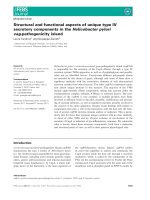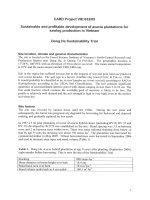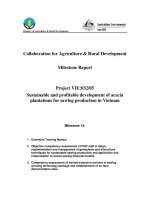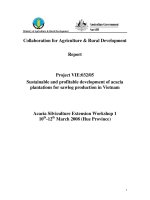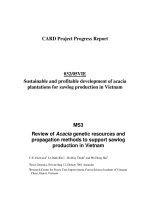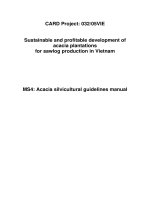Growth and luminescence characteristics of indium nitride for optoelectronics applications in the 1 55 micron region
Bạn đang xem bản rút gọn của tài liệu. Xem và tải ngay bản đầy đủ của tài liệu tại đây (6.19 MB, 164 trang )
GROWTH AND LUMINESCENCE CHARACTERISTICS
OF INDIUM NITRIDE FOR OPTOELECTRONICS
APPLICATIONS IN THE
1.55-MICRON REGION
SEETOH PEIYUAN, IAN
(M.Eng. Massachusetts Institute of Technology)
A THESIS SUBMITTED
FOR THE DEGREE OF DOCTOR OF PHILOSOPHY
IN ADVANCED MATERIALS FOR MICRO- AND NANO-
SYSTEMS (AMM&NS)
SINGAPORE-MIT ALLIANCE
NATIONAL UNIVERSITY OF SINGAPORE
2014
i
DECLARATION
I hereby declare that this thesis is my original work and it
has been written by me in its entirety. I have duly
acknowledged all the sources of information which have
been used in the thesis.
This thesis has also not been submitted for any degree in
any university previously.
______________________
Seetoh Peiyuan, Ian
30 November 2014
ii
Acknowledgements
I would like to thank Prof. Chua Soo Jin and Prof. Eugene Fitzgerald
for their guidance and support over the years, enabling me to approach my
PhD research with confidence, helping me overcome difficulties, as well as
challenging me towards greater excellence along the way. I would also like to
express my gratitude to Dr. Soh Chew Beng for his patient mentoring and also
for imparting to me essential experimental skills.
Also, I would like to thank staff and students of the Centre of
Optoelectronics, namely: Dr. Huang Xiaohu, Dr. Tay Chuan Beng, and Mr.
Patrick Tung for their help with the photoluminescence equipment, Dr. Wee
Qixun, Mr. Ho Jian Wei, Mr. Zhang Li, Mr. Kwadwo, and Mr. Rayson Tan for
their help with the metal organic chemical vapor deposition system, Mr. Tan
Beng Hwee and Ms. Musni bte Hussain for their technical and administrative
support, as well as many others who have contributed to a very pleasant
working environment.
In addition, I would like to thank the Institute of Materials Research
and Engineering for providing the necessary fabrication and characterization
tools, where Mr. Glen Goh, Ms. Doreen Lai, Ms. Vivian Lin, Mr. Lim Poh
Chong, and Ms. Tan Hui Ru were especially helpful in providing assistance to
the use of several essential tools.
Lastly, I would like to thank SMA for providing the funding and
facilitating my PhD program, especially to Prof. Choi Wee Kiong and Ms.
Hong Yanling for their support. Also, I would like to thank my fellow SMA
students, with whom I had memorable experiences taking lessons at the MIT.
iii
Table of contents
Summary vi
List of Tables viii
List of Figures viii
List of Symbols xv
Chapter 1 : Introduction 1
1.1. Background 1
1.1.1. InN’s band gap controversy 1
1.1.2. Recent developments in the epitaxial growth of InN 3
1.2. Motivation 10
1.2.1. InN for optical communications 10
1.2.2. Challenges in the MOCVD growth of InN 14
1.3. Objectives 23
1.4. Major Contributions 24
1.5. Outline of thesis 25
Chapter 2 : Experimental tools and procedures 27
2.1. Metal organic chemical vapor deposition 27
2.2. Photoluminescence measurements 31
2.3. UV-assisted electrochemical etching of GaN 33
2.4. Imaging tools 36
2.5. High resolution X-ray diffraction 38
Chapter 3 : Growth of InN by MOCVD 41
3.1. Introduction 41
3.2. Important considerations 41
iv
3.2.1. Controlling morphology of InN grown on GaN 41
3.2.2. Reducing dislocation densities 43
3.2.3. Reducing background electron concentration 45
3.3. Growth experiments 45
3.3.1. Substrates and growth conditions 45
3.3.2. General observations 48
3.4. Summary 52
Chapter 4 : Characteristics of carrier recombination and optical emission
from InN 54
4.1. Introduction 54
4.2. Non-radiative Auger and SRH processes 56
4.2.1. Theory: Double-Arrhenius law and power law 56
4.2.2. Influence of Auger and SRH processes on PL intensities 64
4.3. Radiative recombination in InN 72
4.3.1. Theory: ‘Band-to-tail’ PL lineshape model 72
4.3.2. Lineshape analysis of PL spectra 79
4.4. Summary 83
Chapter 5 : Nucleation characteristics of InN on GaN 85
5.1. Introduction 85
5.2. Effects of surface treatment with InGaN 87
5.3. Effects of adjusting V/III ratio on nucleation 91
5.4. Summary 95
Chapter 6 : Morphology and optical emission properties of InN grown on
nanoporous GaN templates 97
6.1. Introduction 97
6.2. Fabrication of nanoporous GaN substrates 97
v
6.3. Microstructure of InN grown on nanoporous GaN 100
6.3.1. Structural analysis 100
6.3.2. Growth mechanism 107
6.4. Optical emission from InN grown on nanoporous GaN 111
6.5. Summary 116
Chapter 7 : Conclusion 118
7.1. Summary 118
7.2. Future work 121
7.2.1. Reducing free electron concentrations 121
7.2.2. Device applications 123
7.3. Concluding remarks 124
Appendices 126
A.1. List of MOCVD-grown InN samples 126
A.2. Calculation of dislocation densities by X-ray diffraction 128
A.3. Angle and distance between hexagonal planes 132
A.4. Biography 133
A.5. Publication list 133
A.5.1. Academic theses 133
A.5.2. Research journals 133
A.5.3. Participation in international conferences 134
Bibliography 135
vi
Summary
Since the revision of its optical band gap from 1.9 eV to around 0.75
eV, InN has received considerable attention to its ability to emit near-infrared
radiation at around the 1.55 μm region that is essential for fibre-optics
communication. Nevertheless, InN-based light-emitting or laser diodes are
currently unavailable commercially due to poor material quality linked to
difficulties in epitaxial growth by metal organic chemical vapor deposition,
resulting in rough films with high dislocation densities of above 10
10
cm
-2
.
Also, the optical processes leading to InN’s optical emission are poorly
understood, especially with regards to its relationship to crystalline quality. To
address these issues, we have studied the carrier recombination behavior in
InN through a series of photoluminescence measurements and developed
improved techniques of InN epitaxy on GaN surfaces.
The radiative recombination of InN was found to obey a ‘band-to-tail’
model, whereby the near-infrared optical emission is primarily due to
recombination between degenerate electrons in the conduction band and
photoexcited holes in the tail of the valence band. Non-radiative
recombination, comprising of Auger and Shockley-Read-Hall processes,
lowered the internal quantum efficiency of the material to as low as 3%,
resulting in poor emission intensities at room temperature. Both Auger and
Shockley-Read-Hall recombination were found to be thermally-activated, with
Auger recombination dominating at low temperatures. Shockley-Read-Hall
recombination is more significant in samples of poor crystalline quality,
resulting in its dominance over Auger recombination at room temperature.
vii
We have developed several useful growth techniques that led to growth
of smoother InN material on GaN, along with higher internal quantum
efficiencies. As InN typically grows in an N-rich condition that is limited by
the availability of In precursors, decreasing the V/III ratio during growth
increases the thermodynamic driving force that leads to much higher
nucleation rates and resulting in better surface coverage. In addition, the high
surface energies that act as a barrier to nucleation of InN on GaN can be
reduced by performing an InGaN surface treatment procedure or by using
nanoporous GaN substrates. Nanoporous GaN was fabricated by the
electrochemical etching of GaN by aqueous potassium hydroxide in the
presence of ultraviolet light. The process creates many hexagonal sub-100 nm
pores in the otherwise smooth GaN surface, which presents numerous surfaces
for InN rapid nucleation.
The internal quantum efficiency of InN rises to 20% in samples grown
on nanoporous GaN. This is attributed to the relief of biaxial stress arising
from the lattice mismatch between GaN and InN through the lateral
overgrowth of InN over GaN nanopores. This results in the resultant InN
having fewer dislocations, which act as non-radiative Shockley-Read-Hall
recombination centers. Overall, a combination of InGaN preflow, high V/III
ratios, and nanoporous GaN substrates leads to improved morphology,
crystalline quality, and optical emission efficiencies, which is vital for future
applications in optoelectronic devices.
viii
List of Tables
Table 1-1: Selected physical parameters of materials in InN/GaN and InGaAsP
material systems related to optical emission at 1.55 μm [38-40, 42-43]. 13
Table 1-2: Lattice mismatch of relevant substrate materials with c-InN (In-
plane lattice parameter a
InN
= 3.538 Å) 18
Table 4-1: k values under various conditions in the power law: I P
k
. 64
Table 4-2: Calculated values of parameters related to the PL lineshape analysis
of InN’s temperature-induced blue-red spectral shifts 81
Table 6-1: List of InN samples used for structural comparisons in Section 6.3.
100
Table A-1: List of InN samples grown by MOCVD, together with important
growth parameters*. 126
List of Figures
Fig. 1-1: The group-III nitride material system, compared to other III-V and II-
VI material systems. Image taken from Ref. [11]. 2
Fig. 1-2: Atomic force microscopy images of InN grown at 450
o
C on GaN
templates by plasma-assisted MBE under (a) In-rich conditions (In flux = 13.5
nm/min, N flux = 10.5 nm/min), and under (b) N-rich conditions (In flux = 8.5
nm/min, N flux = 10.5 nm/min). In droplets were not visible in (a) as they
were removed after growth using HCl etch. Images taken from Ref [18]. 5
Fig. 1-3: Scanning electron microscopy images of InN grown by MBE on
GaN/c-sapphire at 450
o
C under In-rich conditions (a) without and (b) with
nitrogen radical beam irradiation which removed In droplets, resulting in a
very smooth InN film of r.m.s. roughness < 1 nm. Images taken from Ref [16].
5
Fig. 1-4: Scanning electron microscope images of InN grown on GaN/c-
sapphire by MOCVD at 510
o
C at a V/III ratio of 12,460 (a) with constant TMI
flow and (b) with pulses of TMI flow (36 sec pulse, followed by 18 sec
interruption). The dark regions in (a) are In droplets. The InN sample in (b) is
free of In droplets and has a r.m.s. roughness of 9 nm. Images are taken from
Ref. [26]. 7
Fig. 1-5: Atomic force microscope images of InN grown by MOCVD on c-
GaN/sapphire at 450
o
C with increasing CBrCl
3
flows: (a) Molar flow ratio:
CBrCl
3
/TMI = 0, r.m.s. roughness = 40 nm. (b) Molar flow ratio: CBrCl
3
/TMI
ix
= 0.02, r.m.s. roughness = 25 nm. (a) Molar flow ratio: CBrCl
3
/TMI = 0.04,
r.m.s. roughness = 6.8 nm. (a) Molar flow ratio: CBrCl
3
/TMI = 9.28, r.m.s.
roughness = 1.6 nm. Images taken from Ref. [31] 9
Fig. 1-6: Trend of global mobile traffic between 2010 and 2018. Image taken
from Ref. [32]. 11
Fig. 1-7: Infrared emission from an InN-based LED [33], with its peak
emission coinciding with point of lowest attenuation in silica fibers [34]. 11
Fig. 1-8: Decomposition temperatures of InN at 100 mbar under different
ambient: hydrogen (top), nitrogen (middle) and in mixed nitrogen ammonia
ambient (75% ammonia, bottom). Image taken from Ref. [24] 15
Fig. 1-9: (left) In droplets formed together with InN (when the growth
temperature is too low, appearing as the In (101) peak in XRD ω-2θ rocking
curve scans (right). The InN and In droplets were grown on a
GaN/AlGaN/AlN/Si(111) template. 15
Fig. 1-10: Amorphous SiN
x
formed during an attempt to grow InN directly on
Si (111) with preflow of TMI. 17
Fig. 1-11: Melting points of Group III nitrides and equilibrium N
2
pressures
from high pressure experiments and theoretical calculations. Image taken from
Ref. [56]. 20
Fig. 1-12: Calculated band diagram and associated carrier concentrations near
the surface for n-type InN doped with N
d
= 8 x 10
18
cm
-3
in (a) and (c)
respectively, and for p-type InN doped with N
a
= 2.3 x 10
19
cm
-3
in (b) and (d).
For the n-type case, the free hole concentration (~10
8
cm
-3
) is negligible,
hence it is not pictured. Figures taken from Ref. [57]. 21
Fig. 1-13: Hall mobility and carrier concentration of InN layers grown by both
MBE and MOCVD techniques, as a function of film thickness. Mobilities are
mostly comparable for both techniques for the same thickness while MOCVD
layers exhibit higher free electron concentration. Image taken from Ref. [23].
22
Fig. 2-1: (a) The Emcore D125 MOCVD system. (b) Samples are introduced
into the growth chamber via a sample load lock to prevent contamination of
the growth chamber. The gaseous reactants enter the chamber from the top via
several inlets 30
Fig. 2-2: Reflectivity of the wafer carrier (with GaN/c-sapphire substrates) at
700 nm during MOCVD growth of InN. Growth occurs when TMI flow is
introduced, with ammonia and nitrogen gas flowing in the background. (a)
Slow growth rate of InN nanoislands at V/III ratio of 55,000 – Sample C1. (b)
Fast growth rate of InN film at V/III ratio of 15,000 – Sample C3. Further
information about these samples is provided in Chapter 5 and Appendix A1. 30
Fig. 2-3: Photoexcitation of charge carriers which subsequently relax
energetically and undergo Auger, Shockley-Read-Hall (SRH), and radiative
x
recombination near the band edges of a semiconductor material. The radiative
recombination results in PL emission. 32
Fig. 2-4: Schematic diagram of the PL measurement system. 32
Fig. 2-5: Schematic diagram of the experimental setup used in the UV-assisted
electrochemical etching of GaN to produce nanopores. 34
Fig. 2-6: (a) SEM image of hexagonal nanopores formed in GaN after UV-
assisted electrochemical etching with aqueous KOH. (b) – (d) Illustration of
the electrochemical etching mechanism. Point (1) indicates the dissolution of
GaN. Point (2) indicates that the etching occurs predominantly at the crystal
grains and not at the dislocations. Point (3) indicates nanopores being left
behind, creating a network. Figures taken from Ref. [70]. 35
Fig. 2-7: (a) The JEOL JSM 6700F field emission scanning electron
microscopy (SEM) system. (b) The Veeco DI Multimode atomic force
microscopy (AFM) system (Picture taken from ).
Images from a sample of InN nanoislands grown on GaN/sapphire (Sample
C2, see Appendix A1) were obtained by (c) SEM and (d) AFM. 37
Fig. 2-8: (a) The Jeol 2100 TEM system. (Picture taken from
). (b) TEM image of an InN nanoisland (Sample A3,
see Appendix A1) grown on GaN (top) and its corresponding EDX map
(bottom) that shows the distribution of In (red) and Ga (atoms). 38
Fig. 2-9: Geometry of X-ray diffraction. The incoming X-ray beam strikes the
crystalline sample’s surface at an angle ω. The diffracted beam leaves the
sample an angle 2θ from the incident beam and is collected by a detector. The
sample can be rotated along the ω, χ, and
axes. The
axis is the sample’s
surface normal, while the χ axis is the line of the X-ray’s path projected onto
the plane of the sample. 39
Fig. 3-1: Schematic representations of (a) Frank-van-der-Merve growth – a
layer-by-layer growth mode, (b) Volmer-Weber growth – three-dimensional
growth of islands, and (c) Stranski-Krastanov growth, where islanding occurs
after a several layers of layer-by-layer growth. Image taken from Ref. [74]. . 42
Fig. 3-2: Schematic diagram of InN growth experiments on various substrates,
resulting in four sets of samples. The structure of InGaN grown in Samples C1
to C3 will be elaborated in Chapter 5. A summary of growth conditions and
InN’s morphology is provided in Appendix A1. 48
Fig. 3-3: Typical XRD scans obtained from InN samples. (a) ω-2θ scan
showing the c-axes of GaN and InN to be aligned. The strain-free position of
InN is indicated by the dashed vertical line. (b) Pole figure
scan of InN,
GaN, and sapphire showing that (c) the hexagonal faces of InN and GaN
crystals are aligned to each other, while twisted 30
o
relative to sapphire’s. Data
obtained from Sample C2. 49
xi
Fig. 3-4: SEM images of InN nanoislands grown at a V/III ratio of 55,000 (a)
directly on planar GaN (Sample A3), (b) on planar GaN after InGaN surface
treatment (Sample C1), and (c) on nanoporous GaN (Sample B3). (d) InN film
grown at a V/III ratio of 15,000 on planar GaN after InGaN surface treatment
(Sample C3). 50
Fig. 3-5: Density of dislocations with screw or edge character measured by
XRD for a set of InN samples grown on planar GaN. The sample IDs are
indicated accordingly. The dashed line is a guide to the eye. 51
Fig. 3-6: Typical PL emission spectra from InN, taken at different sample
temperatures. The gray circles indicate the peak positions, while the vertical
dotted line is a guide to the eye indicating the peak position at 5 K. Data taken
from Sample C3. 52
Fig. 4-1: Generation of charge carriers by photoexcitation, following by
radiative, Auger, and SRH recombination. Light emitted by radiative
recombination can be analyzed as a PL spectrum. 55
Fig. 4-2: Schematic diagram of Auger recombination which takes place
between (a) two electrons and a hole, or (b) two holes and an electron. 57
Fig. 4-3: (a) PL integrated intensity I measured at different laser excitation
powers P for Sample D4. The exponent k in the power law I P
k
can be easily
calculated by taking the slope of a log-log plot at different temperatures T. (b)
k values at different T for the series of four InN films. The data approaches k =
1 at higher temperatures and k = 2/3 at lower temperatures. Figures taken from
Ref. [61]. 66
Fig. 4-4: Typical normalized PL spectra obtained using different laser
excitation powers P at 5 K and 180 K. At 5 K, the high energy spectral
envelope shifts towards higher energies with higher laser excitation power,
indicating band filling. These spectra were obtained from Sample D1. Figures
taken from Ref. [61]. 67
Fig. 4-5: (a) Arrhenius fits (lines) to I data (symbols) taken at different T for
Sample D1. The double-Arrhenius law describes the data much better than a
single-Arrhenius law. When the axes are inverted in (b), the fit curve can be
regarded as the sum of Auger [1 + s.A
Aug
exp(-E
Aug
/k
B
T)] and SRH [1 +
s.A
SRH
exp(-E
Aug
/k
B
T)] contributions. Figures adapted from Ref. [61]. 69
Fig. 4-6: Low IQE values associated with high A
SRH
values of InN samples
grown on planar GaN templates. The IQE was predicted by a curve [IQE =
100%/(3.9+0.004A
SRH
)] to rise rapidly as A
SRH
tends to zero. Details about the
fit curve will be presented in Chapter 6. 72
Fig. 4-7: Schematic diagram of the ‘band-to-tail’ PL lineshape model
describing radiative recombination between degenerate electrons and holes in
the valence band tail. The holes are concentrated at an energy level (γ
p
2
/2k
B
T
c
)
above the valence band edge. 74
xii
Fig. 4-8: Simulated PL spectra according to model described in Eq. (4.12).
Effects of the (a) H [= E
g
- (γ
p
2
/2k
B
T
c
)] parameter, (b) Fermi energy E
fn
, (c)
carrier temperature T
c
, and (d) width of conduction band tail γ
n
are shown.
Baseline conditions are H = 0.70 eV, E
fn
= 0.80 eV, T
c
= 77 K, and γ
n
= 30
meV. 78
Fig. 4-9: Broadening of simulated PL spectra at increasing free electron
concentrations. The free electron concentrations were varied by adjusting E
fn
as in Fig. 4-8b. 78
Fig. 4-10: Typical lineshape fits (solid lines) to experimental PL data
(symbols) obtained at 5 K and 300 K. The fitting parameters at 5 K and (300
K in brackets) are: H = 0.73 (0.72) eV; E
fn
= 0.79 (0.80) eV; T
c
= 80 (300) K;
γ
n
= 30 (29) meV. The positions of H, peak energy position E
peak
, and E
fn
are
indicated for the fit at 5 K. Data obtained from Sample C2. Figure taken from
Ref. [63]. 79
Fig. 4-11: (a) Fitting curve (solid line) of Eqs. (4.33) and (4.34) to H values [=
E
g
- (γ
p
2
/2k
B
T
c
)] obtained from Sample C1. The energy difference (γ
p
2
/2k
B
T
c
)
between the band gap E
g
and H decreases with temperature, causing the initial
blue shifts. The Varshni behavior in E
g
(dashed curve) then dominates in the
subsequent red-shift. (b) Similar fits to H values for Samples C1, C2, and C3.
(c) The BR spectral shifts in E
peak
accounted by the (γ
p
2
/2k
B
T
c
) and Varshni
effects from Ref. [63]. 81
Fig. 5-1: Competition between the thermodynamic driving force and the
surface energy involved in homogeneous nucleation. 86
Fig. 5-2: Schematic diagram illustrating the heterogeneous nucleation of an
InN spherical cap on GaN. 86
Fig. 5-3: SEM images of InN nanoislands grown on planar GaN (a) for 40 min
after InGaN surface treatment – Sample C1, (b) directly without InGaN for 20
min – Sample A2, and (c) directly without InGaN for 60 min – Sample A3.
The V/III ratio was 55,000 in all cases. 89
Fig. 5-4: Height distributions of InN nanoislands grown in Samples C1, A2,
and A3. The solid lines are Gaussian fits to the data obtained by AFM and
ImageJ. 89
Fig. 5-5: Tilted cross-sectional SEM images of InN grown for 40 min with
InGaN surface treatment at different V/III ratios of (a) 55,000 – pyramidal
islands (Sample C1), (b) 30,000 – coalescing islands (Sample C2), and (c)
15,000 – rough film (Sample C3). 91
Fig. 5-6: Height distribution of InN nanoislands grown in Samples C1, C2,
and C3. The lines are Gaussian fits to the data obtained by AFM and ImageJ.
92
xiii
Fig. 5-7: Cross-section TEM image of Sample C3 obtained under diffraction
imaging conditions with g = 002
InN
and zone axis of [110]
InN
. In
0.25
Ga
0.75
N
nanoclusters were found between InN and GaN 94
Fig. 5-8: Proposed mechanism of InN growth on GaN via surface treatment
with InGaN, resulting in (a) slow growth at high V/III ratio and (b) rapid
growth at low V/III ratio. 94
Fig. 5-9: Dislocation densities measured by X-ray diffraction on InN samples
grown on planar GaN/c-sapphire with and without InGaN surface treatment. 95
Fig. 6-1: Nanoporous GaN substrates fabricated by UV-assisted
electrochemical etching with (a) – (c) 5.0M KOH and over different etching
durations, and for (d) – (f) 60 min at different KOH concentrations. 98
Fig. 6-2: (a) Tilted cross-sectional view of the nanoporous GaN substrate
before InN growth. (b) Top view and (c) side-view of InN grown on
nanoporous GaN by MOCVD for 60 min at a V/III ratio of 55,000 (Sample
B3) 101
Fig. 6-3: Growth evolution of InN on (a – b) nanoporous GaN – Samples B1
and B3, and (c – d) planar GaN – Samples A1 and A3. Growth was performed
at a V/III ratio of 55,000 for (a & c) 10 min and (b & d) 60 min. 102
Fig. 6-4: InN nanoislands grown on (a – b) nanoporous GaN – Samples B2
and B4, and on (c – d) InGaN-treated planar GaN – Samples C1 and C2. The
V/III ratio is varied at (a & c) 55,000 and (b & d) 30,000. 103
Fig. 6-5: InN grown on (a) InGaN-treated planar GaN for 40 min at V/III ratio
of 30,000 – Sample C2, (b) Nanoporous GaN for 60 min at V/III ratio of
55,000 – Sample B3, and (c) InGaN-treated nanoporous GaN for 40 min at
V/III ratio of 30,000, followed by 60 min growth of InN at V/III ratio of
55,000 – Sample B6. 107
Fig. 6-6: Possible growth mechanisms for InN on nanoporous GaN. (Left) A
‘bottom-up’ process where InN grows out of the nanopores. (Right) An
‘overgrowth process’ where InN grows over the nanopores. 109
Fig. 6-7: (Top) Bright-field cross-sectional TEM image of InN grown on
nanoporous GaN in Sample B3. The yellow arrows indicate the positions of
voids formed below InN. (Bottom) Corresponding EDX composition map
which indicates regions with In (red) and Ga (green) atoms. 109
Fig. 6-8: Dark-field cross-sectional TEM images of InN grown on (a) planar
GaN (Sample A3) and (b) nanoporous GaN (Sample B3), under diffraction
imaging conditions with g = 1-10
InN
that enables the observation of edge-type
dislocations (yellow arrows) in the form of white lines. (c) The corresponding
selected area diffraction pattern with the zone axis of [110]
InN
where the
diffraction imaging was performed. 111
Fig. 6-9: PL spectra of InN grown on nanoporous and planar samples. The
emission spectra at 300 K were compared to the normalized spectra obtained
xiv
at 77 K. The samples were grown at V/III ratios of (a) 55,000 – Samples A3
and B3, and (b) 30,000 – Samples A4 and B4. Figures taken from Ref. [62].
112
Fig. 6-10: IQE at 300 K as a function of A
SRH
for InN samples grown on
nanoporous GaN (Samples B3 to B6), InGaN-treated planar GaN (Samples C1
to C3), and planar GaN (Samples A3, A4, D1). The solid line describes the
reciprocal relationship between IQE and A
SRH
according to Eq. (6.3). Figure
adapted from Ref. [62]. 115
Fig. 7-1: Schematic diagram illustrating the iterative process between optical
characterization and growth improvements of InN. 121
Fig. 7-2: Free electron concentration at 300 K of InN samples grown on
different types of GaN substrates: planar GaN (circles) – Samples A3 and A4,
InGaN-treated planar GaN (squares) – Samples C1, C2, and C3, and
nanoporous GaN (triangles) – Samples B3 B4, and B6, at different V/III
ratios. 122
Fig. A2-1: A typical ω scan profile by high resolution XRD. Data is taken by
scanning the InN (002) plane of Sample C3 and is fitted with a Pseudo-Voigt
function, which can measure the full-width at half maximum Δω
hkl
and the
profile shape factor f indicating the fraction of Lorentzian character in the
lineshape. 128
Fig. A2-2: Lattice twist Δω
twist
of a GaN sample estimated by extrapolating
Δω
hkl
values to χ = 90
o
. Note the large number of data points required for a
reliable curve fit using Eq. A2.4. Figure obtained from Ref. [78]. 129
Fig. A2-3: (a) Lattice tilt Δω
tilt
calculated using Eq. A2.5. (b) Lattice twist
Δω
twist
calculated using Eq. A2.6. Data obtained from Sample C3 (Δω
tilt
=
0.480
o
, Δω
twist
= 0.559
o
) by performing XRD ω scans about the indicated InN
crystal planes. 131
xv
List of Symbols
ΔG Free energy of formation
ΔG
*
Activation energy of nucleation
ΔG
v
Free energy of reaction per unit volume
Δn Steady-state concentration of photoexcited electrons
Δn Steady-state concentration of photoexcited holes
Δω
hkl
Full-width at half maximum of an XRD ω scan of hkl planes
Δω
tilt
Angle associated with lattice tilt
Δω
twist
Angle associated with lattice twist
α, β Varshni parameters
χ Inclination of crystal planes relative to surface normal
ε Permittivity
ε
o
Permittivity of free space (= 8.854 x 10
-12
m
-3
kg
-1
s
4
A
2
)
In-plane rotation angle during X-ray diffraction
γ
n
Impurity potential of conduction band tail
γ
p
Impurity potential of valence band tail
λ Wavelength of X-rays used in X-ray diffraction
ψ Contact angle during heteronucleation
σ Surface energy
xvi
σ
i
Surface energy/tension of material i
σ
i/j
Interfacial energy between materials i and j
θ Bragg angle during X-ray diffraction
A
Aug
Number of Auger recombination centers
A
i
Surface area of material i
A
SRH
Number of Shockley-Read-Hall recombination centers
A
n
, A
p
Shockley-Read-Hall recombination constants
B
n
, B
p
Radiative recombination constants
B(X) Kane’s density of states function
C
n
, C
p
Auger recombination constants
C(E) Describes non-parabolicity of conduction band
D
edge
Density of dislocations with an edge character
D
screw
Density of dislocations with a screw character
E Energy
E
Aug
Activation energy of Auger recombination
E
f
Fermi energy
E
fn
Quasi-Fermi energy of electrons
E
g
Band gap
E
g
(0) Band gap at 0 K
xvii
E
n
Energy of electrons in the conduction band
E
o
Parameter accounting for non-parabolicity of conduction band
E
p
Energy of holes in the valence band
E
SRH
Activation energy of Shockley-Read-Hall recombination
G Generation rate of charge carriers
H Energy separation between electrons and holes
I Photoluminescence integrated intensity
I(hν) Photoluminescence spectrum
IQE Internal quantum efficiency
K Magnitude of reciprocal lattice vector
L Correlation length
N Nucleation rate
N(E
n
) Energy distribution of electrons
N
a
Concentration of electronic acceptors
N
d
Concentration of electronic donors
N
i
Concentration of ionized impurities
P Laser excitation power
P(E
p
) Energy distribution of holes
R
Aug
Auger recombination rate
xviii
R
L
Radiative recombination rate
R
SRH
Shockley-Read-Hall recombination rate
T Temperature
T
c
Carrier temperature
a, a
i
In-plane lattice parameter (of material i)
c Out-of-plane lattice parameter
d Distance between lattice planes
e Elementary charge (= 1.602 x 10
-19
C)
f Fraction of Lorentzian character in the Pseudo-Voigt function
f(ω) Pseudo-Voigt function
f
n
(E) Fermi-dirac function
g Diffraction direction during TEM diffraction imaging
g
n
(E) Electron density of states
h Planck constant (= 6.626 x 10
-34
Js)
ħ Reduced Planck constant (= h/2π)
k Exponent in power law of I P
k
k
B
Boltzmann constant (= 1.381 x 10
-23
m
2
kgs
-2
K
-1
)
n Dimensionless constant (= 1 + (1 – f)
2
)
n
d
Order of diffraction during X-ray diffraction
xix
n
Hall
Free electron concentration measured by Hall effect
n
I
Parameter related to SRH recombination
n
o
Free electron concentration
n
PL
Free electron concentration measured by photoluminescence
n
r
Refractive index
m
e
*
Effective mass of electrons
m
o
Electron rest mass (= 9.109 x 10
-31
kg)
p
I
Parameter related to SRH recombination
p
o
Free hole concentration
r Radius of sphere
r
*
Critical radius during nucleation
s Spot size of laser during PL measurements (4 mm
2
)
t Time
x Parameter linking IQE to A
SRH
y Parameter linking IQE to A
SRH
1
Chapter 1 : Introduction
1.1. Background
1.1.1. InN’s band gap controversy
During the International Workshop on Nitride Semiconductors in year
2000 (IWN-2000), it was agreed in a private discussion between by V.
Davydov and F. Bechstedt that InN should have a band gap of less than 0.9 eV
based on recent theoretical simulation and photoluminescence (PL) results,
much smaller than the previously-thought of value of 1.9 eV [1]. However,
their documented reports did not appear in the scientific literature until 2002,
due to fierce criticism by reviewers in several peer-reviewed journals and even
from their own colleagues as their findings were considered to be very
controversial at that time. Eventually, their results were published in the
Physica Status Solidi (b) and the Journal of Crystal Growth [2-3]. Subsequent
validation by other groups using single crystalline material (see next section)
grown by plasma-assisted molecular beam epitaxy (MBE) and metal organic
chemical vapor deposition (MOCVD) confirmed the optical band gap of InN
to be at around 0.7 to 0.8 eV [4-5]. The previous large value of 1.9 eV
measured by optical absorbance using sputtered polycrystalline InN samples
was attributed to large Burstein-Moss shifts.
The revised narrow band gap lies in the near-infrared region and has
generated immense interest in InN over the last decade. It can be seen from the
Group III nitride material system in Fig. 1-1 that with GaN having a band gap
of 3.4 eV, alloying InN with GaN can produce an InGaN material system that
2
stretches from the near-infrared to the near-ultraviolet region. These materials
have a hexagonal wurtzite crystal structure and have direct band gaps
encompassing the entire visible spectrum, which are potentially useful in new
applications like phosphor-free white LEDs and full spectrum solar cells [6-7].
Band bending near the surface of InN was found to be useful in producing
terahertz radiation which can used to detect metallic weaponry and chemical
explosives in security screenings [8]. Also, when incorporated as a channel
layer in a high electron mobility transistor (HEMT), the resultant two-
dimensional electron gas (2DEG) at an InGaN/InN heterojunction is predicted
to have very high sheet carrier densities (> 10
14
cm
-2
) and saturated drift
velocities (> 10
7
cm/s) [9-10], enabling high-speed applications in the next
generation of GaN-based HEMTs.
Fig. 1-1: The group-III nitride material system, compared to other III-V and
II-VI material systems. Image taken from Ref. [11].
3
1.1.2. Recent developments in the epitaxial growth of InN
Early attempts in InN growth by radio-frequency sputtering produced
polycrystalline films [12-13]. These materials have very high free electron
concentrations exceeding 10
20
cm
-3
and were unable to exhibit
photoluminescence (PL). The films appeared red and were determined to have
a band gap of around 1.9 eV based on optical absorbance measurements.
However, the high free electron concentration resulted in very large Burstein-
Moss shifts, where the electrons fill up the conduction band of the material.
Coupled with oxygen impurities that increased the band gap by essentially
alloying InN with In
2
O
3
, optical absorbance occurred at very large energy
levels that overestimated InN’s band gap [4].
In recent years, improvements in MBE and MOCVD enabled growth
of black-colored single-crystalline InN with much lower free electron
concentrations (as low as 10
17
cm
-3
). These materials were grown on c-
sapphire or silicon (111) substrates via buffer layers like nitrided sapphire [14-
15], GaN [15-16], and AlN [5, 17]. More information about growth substrates
and buffer layers will be presented in Section 1.2.2b. These single-crystalline
InN samples had substantially less Burstein-Moss shifts and were of sufficient
high quality for PL measurements to be conducted. The developments led to
InN’s band gap to be revised to around 0.7 to 0.8 eV as described in the
previous section.
1.1.2a. Growth by molecular beam epitaxy
Plasma-assisted MBE is the growth technique that currently produces
the best growth results for InN. In the process occurring at ultrahigh vacuum
(~10
-8
Pa), the indium flux is provided by an effusion cell containing the solid
4
indium source, while the nitrogen plasma source maintains a steady flux of
nitrogen independent of the growth temperature. The latter is a very
advantageous characteristic as nitrogen atoms evaporate very easily away
from the InN crystal lattice at elevated temperatures, resulting in the thermal
decomposition of InN and very little growth (see Section 1.2.2). At growth
temperatures of around 450 to 550
o
C, the steady N flux provided during
plasma-assisted MBE enables fast growth rates of 1 – 3 μm per hour.
The V/III ratio during plasma-assisted MBE is controlled by the
relative rates of In and N flux and is very important in determining the quality
of the material. Initially, N-rich conditions were adopted to prevent InN
decomposition. However, such conditions limit the surface mobility of
adatoms during epitaxy as In adatoms are more mobile than N adatoms during
epitaxy. This results in rough morphologies with r.m.s. roughness ≈ 50 nm
(Fig. 1-2b) and high dislocation densities [18-19].
On the other hand, MBE growth under In-rich conditions encourages
step-flow of adatoms around spirals (Fig. 1-2a), resulting in smoother material
(r.m.s. roughness ≈ 10 nm) [18]. However, it has the disadvantage of
producing In droplets in the material. Therefore, in order to produce smooth
and droplet-free films, most InN growth by MBE is performed at molar flow
conditions near stoichiometric (1:1) In/N ratios [20]. Recently, In droplets
were successfully removed during In-rich growth by irradiation with nitrogen
radicals (Fig. 1-3) [16]. This enabled droplet-free growth under In-rich
conditions, resulting in very smooth films of InN (r.m.s. roughness < 1 nm).
5
Fig. 1-2: Atomic force microscopy images of InN grown at 450
o
C on GaN
templates by plasma-assisted MBE under (a) In-rich conditions (In flux = 13.5
nm/min, N flux = 10.5 nm/min), and under (b) N-rich conditions (In flux = 8.5
nm/min, N flux = 10.5 nm/min). In droplets were not visible in (a) as they were
removed after growth using HCl etch. Images taken from Ref [18].
Fig. 1-3: Scanning electron microscopy images of InN grown by MBE on
GaN/c-sapphire at 450
o
C under In-rich conditions (a) without and (b) with
nitrogen radical beam irradiation which removed In droplets, resulting in a
very smooth InN film of r.m.s. roughness < 1 nm. Images taken from Ref [16].
MBE enables growth of thick (1 – 5 μm) and smooth films. The
growth process could be monitored in situ by reflection high-energy electron
diffraction (RHEED) which provides real-time information about the growth
rate and crystal structure. This option is unavailable in MOCVD systems. The
deposited material is also very pure as MBE uses elemental reactants
(evaporated In and N plasma), as opposed to more complex reactants in
MOCVD (trimethylindium and ammonia) that results in hydrogen and carbon-

